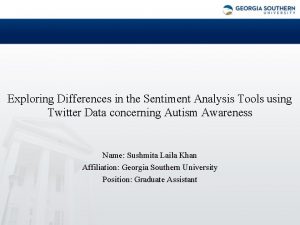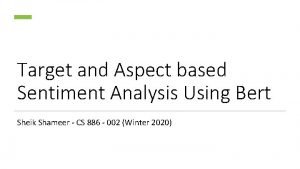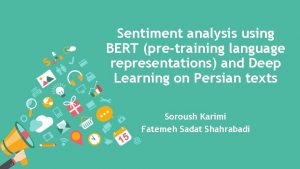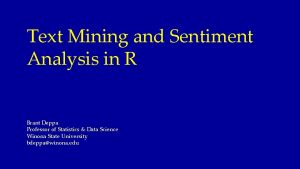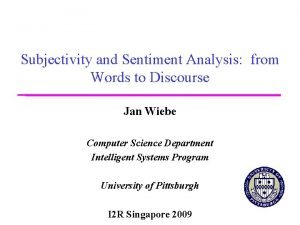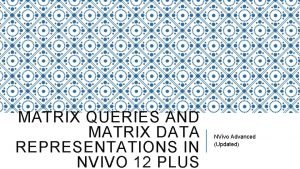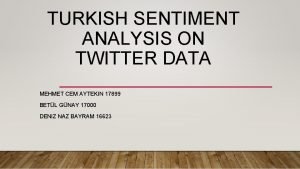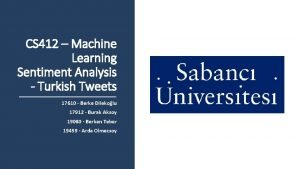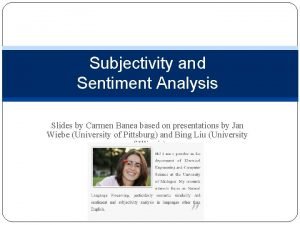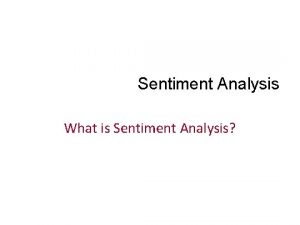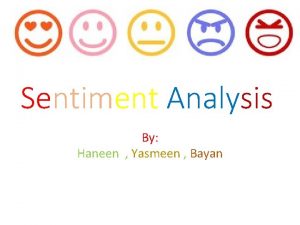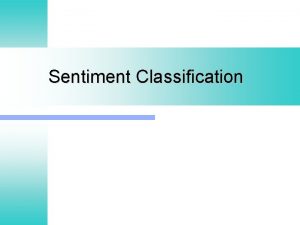Exploring Differences in the Sentiment Analysis Tools using














- Slides: 14

Exploring Differences in the Sentiment Analysis Tools using Twitter Data concerning Autism Awareness Name: Sushmita Laila Khan Affiliation: Georgia Southern University Position: Graduate Assistant

Outline • • Overview Background Data set Data Preprocessing Sentiment Analysis: Tools and Models Results Discussion/Conclusion

Overview • Goal: Analyze twitter data concerning autism awareness and find out which is the better tool for sentiment analysis • Sentiment analysis is the identification of opinions from text to determine how the writer feels about a topic • Evaluate two Python based sentiment analysis tools: – VADER – Scikit Learn • Comparing performance of the tools – Comparison of the results each output and human judgement

Background • Analysis of text data can extract information about business, medicine, and health related topics(e. g autism) • (Knudson et al. , 2016, Ghiassi at al. , 2015, Rodrigues et al. , 2013) • Twitter is a popular data source for text analytics • (Ghiassi et al. , 2015, Abbasi et al. , 2014, Marquez et al. , 2013) • Sentiment polarity refers to the tweet being positive or negative • (Knudson et al. , 2016, Marquez et al. , 2013) • To validate the results, the accuracy, precision, and recall are calculated • (Ghiassi et al. , 2015, Abbasi et al. , 2014, Rodrigues et al. , Marquez at al, 2013, Knudson et al. , 2016, Georgiou et al. , 2015)

Data Set • Twitter data set in CSV format: – Expressing opinions about Autism – Obtained from the College of Public Health, GSU(Dr. Yin, Thank you ) • Data set contains 25 columns and 2000 rows: – – – Tweets Retweets Location User ID Language • Tweets in different language • Tweets have: – – Emoticons Hashtags URLS Usernames

Data Preprocessing • The texts are used only for this study: Column header ‘tweets’ • Rows containing non-English tweets removed • All $URLS, emoticons, #hashtags and @mentions remained • Data exported and saved in a separate CSV file using python’s pandas

Sentiment Analysis: Tools & Models • Tools used for sentiment analysis: – VADER: • Python based sentiment analysis tool • Has scored sentiment corpus – Scikit Learn: • Python based machine learning library • Provides platform for creating model for sentiment analysis • Sentiment corpus must be provided by user

Sentiment Analysis: Vader • Labeled data corpus for Sentiment Analysis • Sentiment. Intensity. Analyzer: library for classifying into groups of sentiments • Results exported in text files • Outputs: – Probability of positive, neutral and negative – Compound values in a range of -1 to 1, where -1 represents negative for each tweet • The compound value is comparable to a single measure of polarity

Sentiment Analysis: Scikit Learn • Used to built a sentiment analysis tool: • Sanders labeled data corpus used for model building • Vectors created used TFIDF Vectorizer: min DF = 0. 02, max DF = 0. 8 • 30% for training set, 70% for test set • Support vector machine algorithm and the classifier library used • Classifies tweets into three groups: Positive, negative, neutral • Values in a range of -1 to 1, where negative(-1), neutral(0), positive(+1)

Results Vader: Sentiment Classification Scikit Learn: Sentiment Classification

Results • Performance of model examined using the measures: – Accuracy: (True Positive + True Negative)/N • Number of instances classified correctly – Recall: True Positive/(False Negative + True Positive) • True positive rate: How many positive instances are predicted correctly – Precision: True Negative / (False Positive + True Negative) • True negative rate: How negative instances are predicted correctly – F 1 -score: 2*(Recall * Precision)/(Recall + Precision) • Weighted Average of precision and recall

Results Tool Accuracy Precision Recall F 1 -Score Vader 67% 44% 67% 53% Scikit Learn 60% 36% 45% In comparison with Human judges

Conclusion • Mostly when people spoke of autism it was in an information sharing or supportive sentiment – Overall there were few negative tweets and most were found as neutral and/or positive • Vader has a higher accuracy: 67% • Vader has predicted more values correctly than scikit learn • Thus for this study, Vader is the better tool • Next Steps: – Apply Vader sentiment analysis to remaining autism set of twitter data (100, 000+ tweets)

Questions ?
 Chenghua lin
Chenghua lin Sentiment analysis tools comparison
Sentiment analysis tools comparison Apache spark twitter
Apache spark twitter Aspect based sentiment analysis bert
Aspect based sentiment analysis bert ü
ü W62vr
W62vr Subjectivity in sentiment analysis
Subjectivity in sentiment analysis Bing
Bing Sentiment analysis nvivo
Sentiment analysis nvivo Sentiment analysis of restaurant reviews
Sentiment analysis of restaurant reviews Hotel review analysis
Hotel review analysis Turkish sentiment analysis
Turkish sentiment analysis Turkish sentiment analysis
Turkish sentiment analysis Azure twitter sentiment analysis
Azure twitter sentiment analysis Carmen banea
Carmen banea

